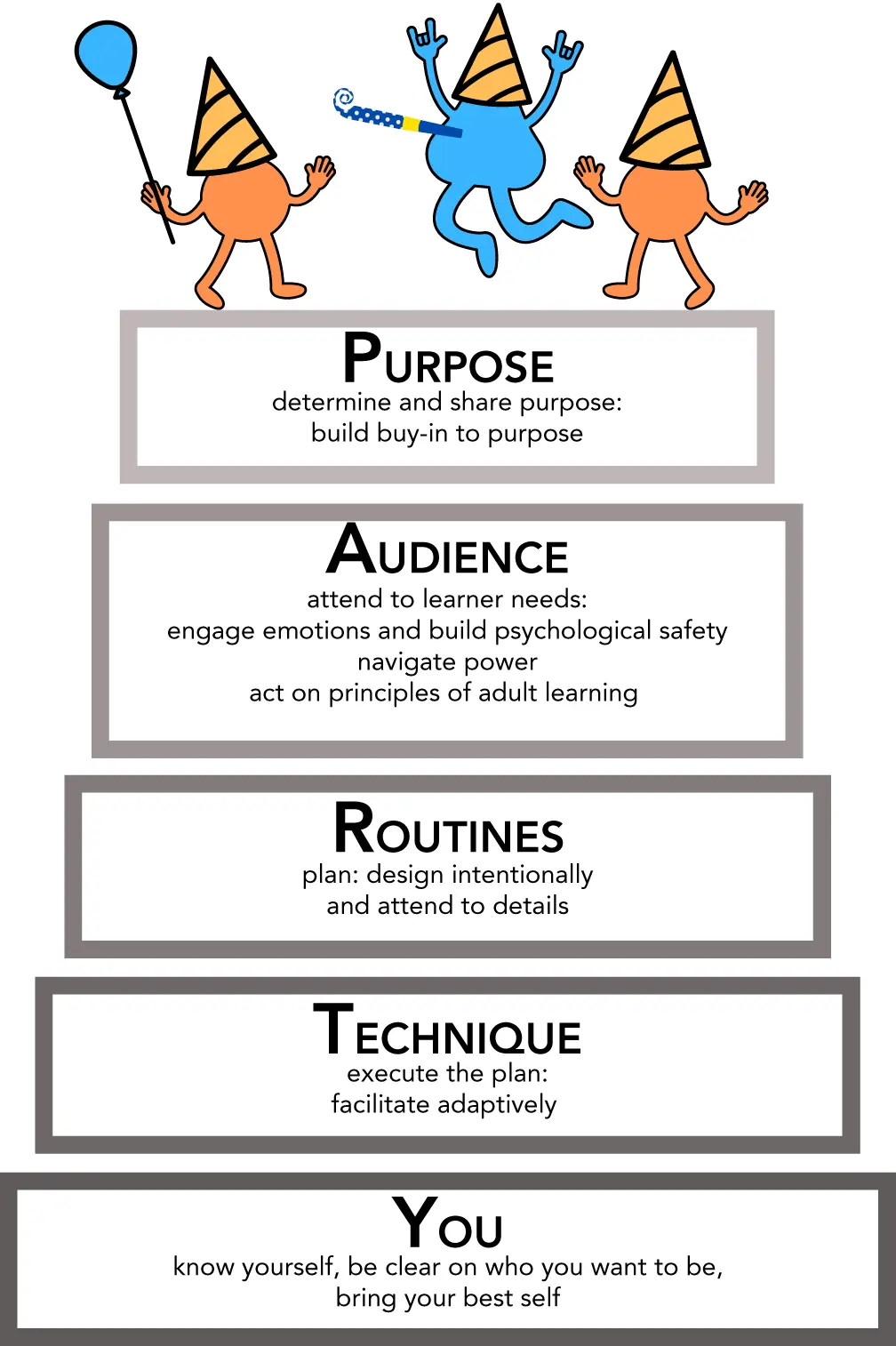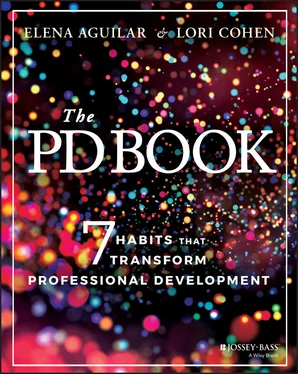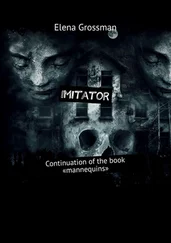Elena Aguilar - The PD Book
Здесь есть возможность читать онлайн «Elena Aguilar - The PD Book» — ознакомительный отрывок электронной книги совершенно бесплатно, а после прочтения отрывка купить полную версию. В некоторых случаях можно слушать аудио, скачать через торрент в формате fb2 и присутствует краткое содержание. Жанр: unrecognised, на английском языке. Описание произведения, (предисловие) а так же отзывы посетителей доступны на портале библиотеки ЛибКат.
- Название:The PD Book
- Автор:
- Жанр:
- Год:неизвестен
- ISBN:нет данных
- Рейтинг книги:5 / 5. Голосов: 1
-
Избранное:Добавить в избранное
- Отзывы:
-
Ваша оценка:
- 100
- 1
- 2
- 3
- 4
- 5
The PD Book: краткое содержание, описание и аннотация
Предлагаем к чтению аннотацию, описание, краткое содержание или предисловие (зависит от того, что написал сам автор книги «The PD Book»). Если вы не нашли необходимую информацию о книге — напишите в комментариях, мы постараемся отыскать её.
The PD Book,
The PD Book
The PD Book — читать онлайн ознакомительный отрывок
Ниже представлен текст книги, разбитый по страницам. Система сохранения места последней прочитанной страницы, позволяет с удобством читать онлайн бесплатно книгу «The PD Book», без необходимости каждый раз заново искать на чём Вы остановились. Поставьте закладку, и сможете в любой момент перейти на страницу, на которой закончили чтение.
Интервал:
Закладка:
Every last detail of the learning experience is anticipated and planned.
Facilitators skillfully execute the learning plan and adapt, responding to learners when necessary.
Facilitators are reflective, see themselves as learners, have a high degree of emotional intelligence and self‐awareness, and can motivate people and inspire them to take risks and to stretch outside of their comfort zones.
These are the conditions for learning. We've taken these, and everything we know about designing and facilitating professional development, and categorized them into seven habits. To help you remember them, we've also come up with an acronym: PARTY. This stands for: Purpose, Audience, Routines, Technique, and You. We hope that Figure 0.1will help you remember the core ideas and habits in this book.
The Seven Habits
Habits are behaviors that you enact so often that you internalize them and they become routine. For example, you probably brush your teeth every day without having to think about how to angle the toothbrush—you just do it. Once a behavior is a habit, it doesn't take as much cognitive, physical, or emotional energy as when you started.

Figure 0.1 How to Create Transformative PD: PARTY!
Many of the strategies we'll describe in this book might sound like they'd take a lot of time and energy—and they do at first. But if you practice them over and over, you'll eventually find yourself doing them with much less intentional labor than you needed at first. Once you reach a stage of mastery or what's also called unconscious competence (Broadwell, 1969), the habit will be ingrained—and possibly almost effortless.
But let's back up, because a habit emerges from a belief: You brush your teeth because you believe that dental hygiene is important and brushing will prolong the health of your teeth. Beneath every habit in this book are beliefs that uphold it. We will make those beliefs explicit to increase your investment in mastering the habits. Table 0.2summarizes the habits and content of this book. You'll also see how the habit contributes to a condition for learning.
Table 0.2 The Seven Habits
| Habit & Chapter | Condition for Learning | Description |
|---|---|---|
| Determine Purpose (1) | Purpose | Transformative PD emerges from purpose. We identify and create purpose, and then we communicate it to learners and build their buy‐in. |
| Engage Emotions (2) | Audience | Human beings have emotions, and we engage our own emotions and those of others to create the conditions for learning. We respond to challenging emotions and create psychological safety for individuals and groups. |
| Navigate Power (3) | Audience | Power is always present, and when we're in hierarchical organizations, we must learn how to use it. We make choices about what kind of power we work from, how we use it, and how we respond to power struggles. |
| Anchor in Adult Learning Principles (4) | We act on the research about what adults need in order to learn. We can provide choice, honor agency, access prior learning, and make the learning relevant. | |
| Design Intentionally (5) | Routines | We honor the backgrounds of participants, consider the why behind design, and are deliberate in determining outcomes, selecting activities, developing learning structures, and sequencing learning. |
| Attend to Details (6) | Attending to details makes learners feel welcome, affirmed, valued, and psychologically safe. | |
| Facilitate Adaptively (7) | Technique | Developing self‐awareness, emotional intelligence, cultural humility, and clear communication enables you to respond appropriately to whatever happens in a PD session. |
You
You might notice that Purpose, Audience, Routines, and Technique each get their own chapter, but none of the habits explicitly addresses you, or the Y in the acronym PARTY. That's because who you are—your behaviors, beliefs, and ways of being—are addressed in every habit. Think of the Y as reminding us of you, of the importance of your presence and of what you bring to every aspect of transformative PD.
A Learning Organization: A Contextual Condition for PD
For PD to be transformative, it helps if an organization is committed to being a learning organization . In a learning organization, everyone is committed to their learning, everyone is expected to learn, and everyone learns. This value shows up in goals and priorities, in evaluations, and in the adult culture. Table 0.3offers a description of a learning organization. As you read each indicator, note whether there's evidence in your organization of the indicator—maybe jot down “yes,” “no,” or “some” in the margin.
We include this here to acknowledge the organizational context in which you lead and facilitate PD. If you work in an organization that doesn't have any of these indicators of being a learning organization and you are committed to designing and delivering transformative PD, we want to acknowledge that it's going to be hard—not impossible, but hard. If this is the situation you're in, you'll need to address the larger organizational culture, while also implementing the strategies we're sharing with you.
Table 0.3 Indicators of a Learning Organization
| Learning Environment | |
| Psychological safety | We can disagree with colleagues or supervisors, we can ask any kind of question, we can make mistakes, and we can express divergent opinions. |
| Appreciation of difference | Our discussions surface differences in ideas, and we have healthy disagreements about ideas. |
| Openness to new ideas | We are encouraged to take risks and try new things, and we do so. |
| Time for reflection | We take time to pause, thoughtfully reflect on our processes, and learn from our experiences. |
| Feedback | We get feedback on our work from multiple sources (including from colleagues and supervisors). |
| Purpose | We feel that our work matters to us personally and is connected to something bigger than us. |
| Learning Processes and Practices | |
| Orientation | Our learning is connected to and in support of the organization's core purpose. |
| Generation | We generate new learning together. |
| Interpretation | We make sense of our learning together. |
| Dissemination | We share what we learn with each other and outside of our group and organization. |
| Leadership | |
| Listening and questioning | Leaders prompt dialogue and debate. |
| Honoring process | Leaders ensure time for reflection, generation, interpretation, and dissemination. |
| Openness | Leaders are willing to entertain alternative points of view. |
| Modeling | Leaders make their learning visible and model the practices of a learner. |
Source: Based on Garvin, Edmondson, and Gino (2008).
What If PD Could Be More Like a Party?
When you became a teacher, it's likely that you formed a vision for who you wanted to be based on two things: who you aspired to emulate, and who you didn't want to be like. This may have been a conscious process or an unconscious one. But often a vision is shaped by what we've experienced and by what we strive to replicate and what we want to reject.
Читать дальшеИнтервал:
Закладка:
Похожие книги на «The PD Book»
Представляем Вашему вниманию похожие книги на «The PD Book» списком для выбора. Мы отобрали схожую по названию и смыслу литературу в надежде предоставить читателям больше вариантов отыскать новые, интересные, ещё непрочитанные произведения.
Обсуждение, отзывы о книге «The PD Book» и просто собственные мнения читателей. Оставьте ваши комментарии, напишите, что Вы думаете о произведении, его смысле или главных героях. Укажите что конкретно понравилось, а что нет, и почему Вы так считаете.












